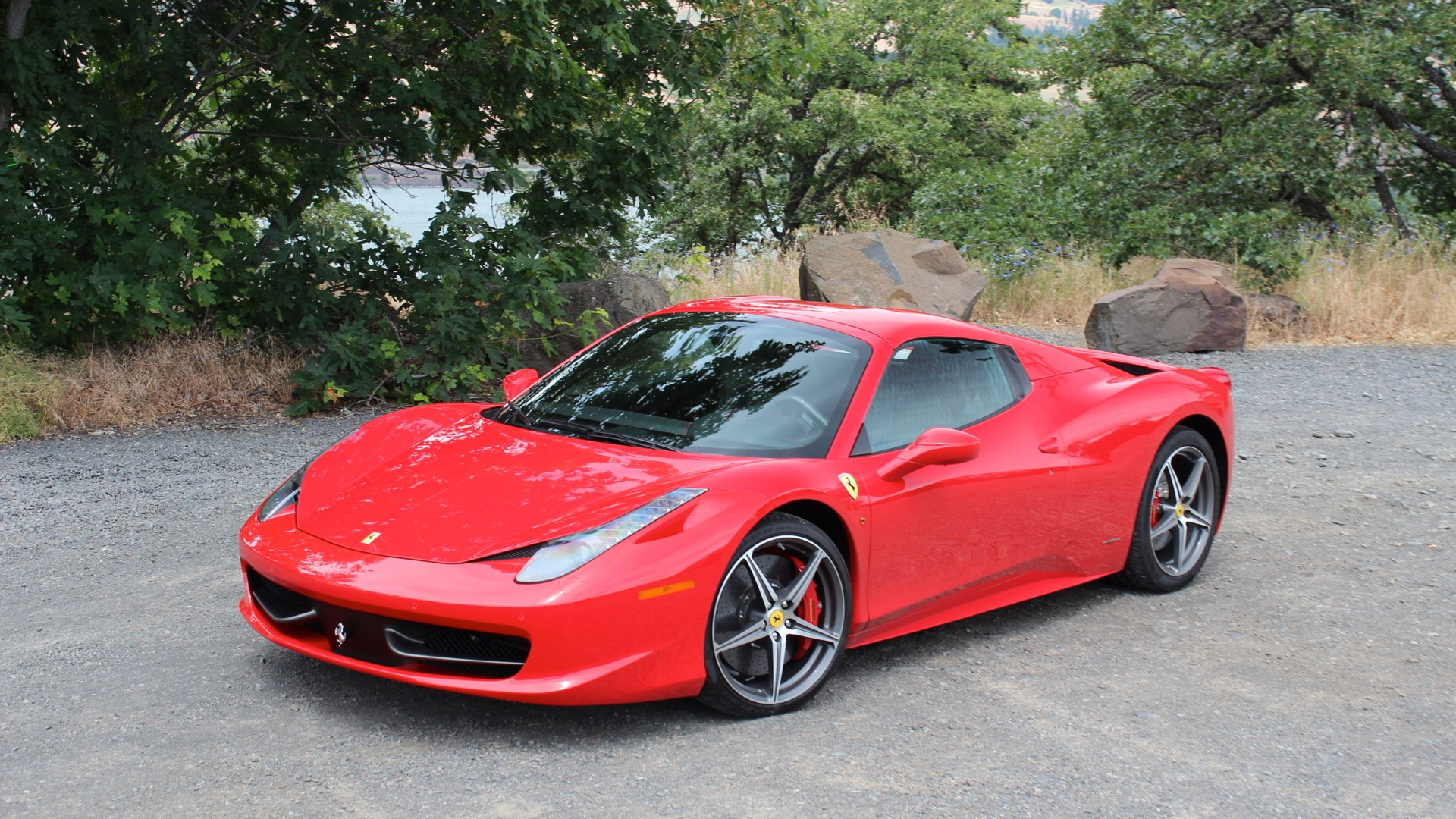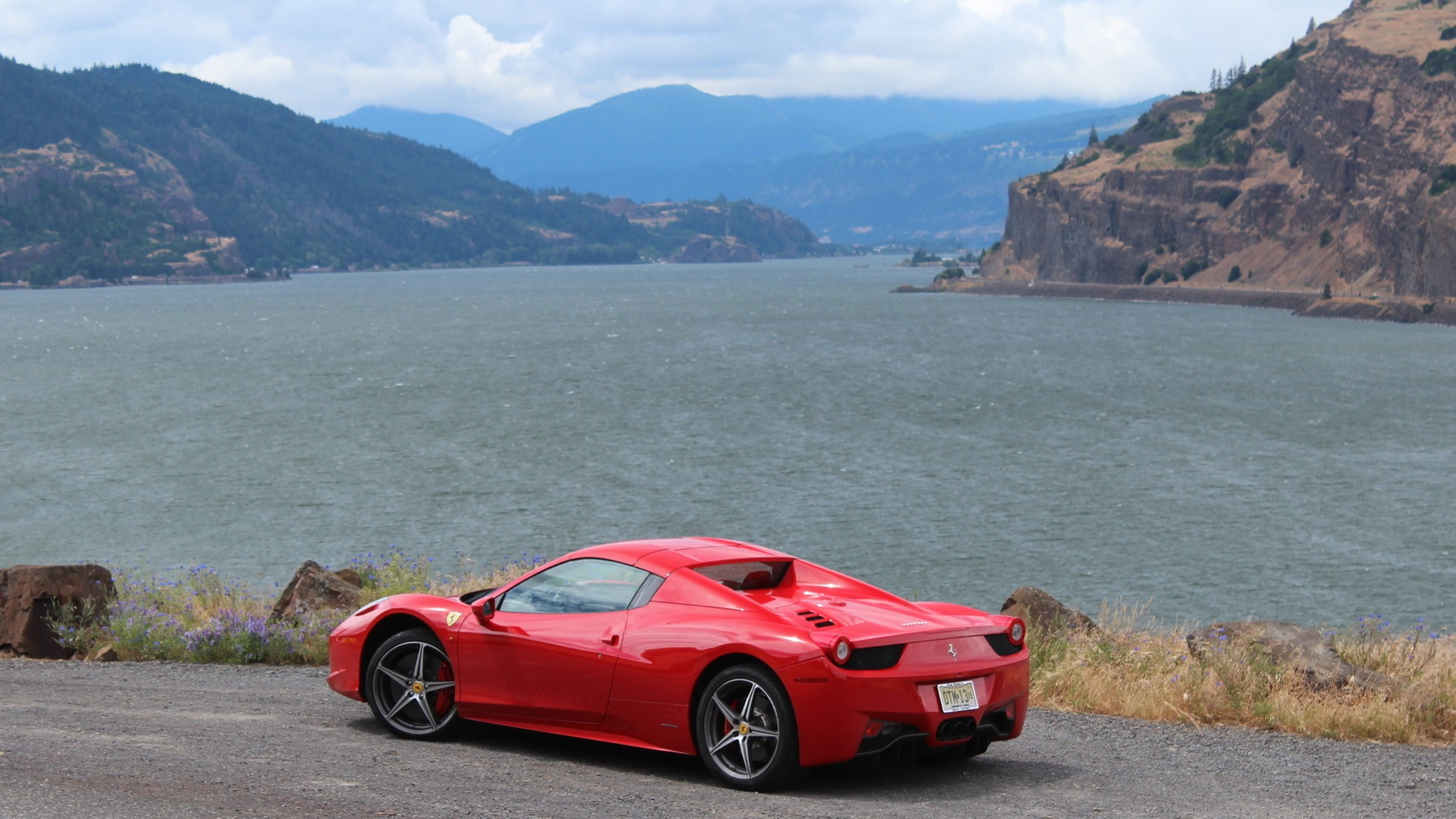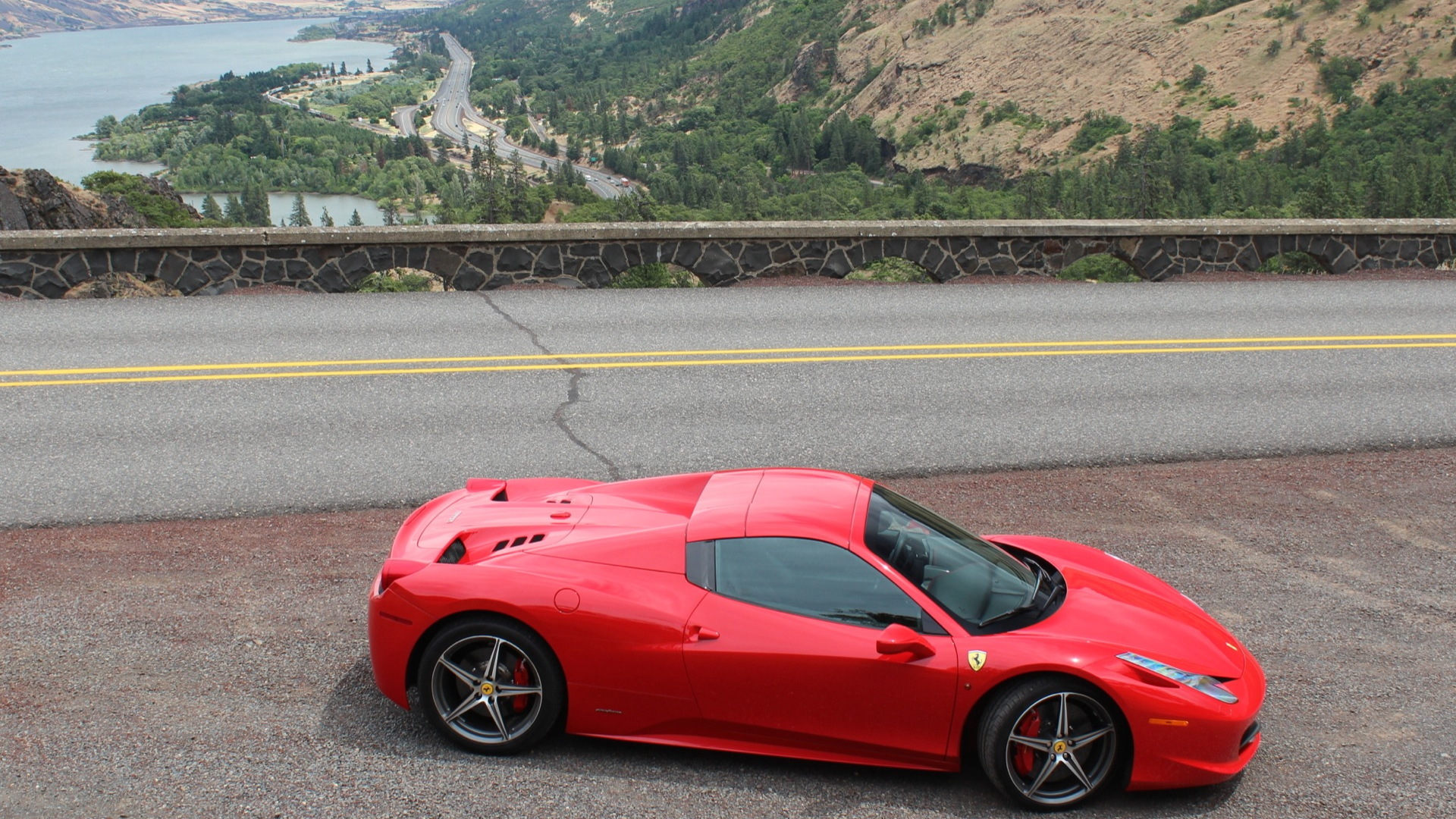Even in today’s supercar-rich automotive landscape, Ferrari stands out as special and awe-inspiring.
Look at the critical numbers for the 2014 458 Spider that we just drove, and it’s in an elite tier among just a few of the world’s top performance machines. The high-revving, 4.5-liter V-8 makes 562 horsepower (570 ps), and it’s hooked up to a seven-speed race-derived dual-clutch gearbox. Top speed is 199 mph, while 60 mph comes in a factory-official time of ‘less than 3.4 seconds.’ It can brake from 62 mph in less than 108 feet, according to Ferrari—and from 124 mph in less than 422 feet.
Those are all nothing to scoff at. They’re scorching by any gauge. But now that we have that out of the way, we can move on to what makes this car such a standout—and not just another status symbol.
ALSO SEE: #GiveAShift: The 7 Best Manual Transmissions You Can Drive
As we point out in our video review above, the 458 is that car. Whether it was the Testarossa, the 308, the 348, the 355, or one of many others, mid-engine Ferraris have always been gorgeous—and a model for what a sports car can be.
But it’s not just that; it’s an onslaught of the senses. In sight and sound, and in poise—as well as performance numbers—the 458 Spider is unparalleled among top-down cars. It’s sexy beyond all the usual cliches, yet it’ll be happy to oblige all of them; it looks technical and racing-influenced in all the right ways; and it emits a soundtrack that will delight even those who typically shake their head at noisy sports cars.
Whether the 458 Spider is your first Ferrari or whether you have a garage full of them, and a fleet manager to boot, we’d venture to say that, based on our scant three days and nearly 350 miles with one earlier this month, it’s probably going to be the one that you as the driver would most enjoy driving out on real roads, at legal (or at least in the vicinity of legal) speeds.
Why more than other Ferraris? Because it embodies everything that we’ve come to appreciate about Ferrari, yet with what we think is more lasting charm and practicality. Although the 458 Spider is quite easy to drive, it can deliver astonishing performance, and with its open-air possibilities it’s more enchanting than any other high-dollar supercar.
CHECK OUT: Official Details On The One-Off Ferrari F12 TRS: Video
First retractable hardtop with a mid-rear engine layout—and wow
Yes, it’s a convertible. The tight-fitting top is very well designed, and it can in less than 20 seconds bring the 458 Spider from a Coupe, visually, to what looks at quick glance like a well-done Targa. Only it’s truly an open-top car.
According to Ferrari, the 458 Italia is the first car ever to combine a mid-rear engine layout with a retractable hardtop.
At the risk of eliciting groans: It’s not a one-trick Itallian stallion. Yes, it’s the latest in a long line of mid-engine Ferraris—and the car we drove lived up to that image, delivered in Rosso Corsa (the classic red), of course. But it’s a car that could really be enjoyed for weekend touring, with a top arrangement that lets you enjoy the car well after the rain overtakes the sun.
We did exactly that, heading out to the golden foothills around the Columbia River Gorge from almost-always-rainy Portland. There we found some beautiful driving roads that allowed us to romp the 458 Spider on mostly smooth road surfaces—albeit on sinewy two-laners with cliffs, rock walls, and drop-offs.
Adding to those concerns is that the 458 Spider is a relatively wide car, for what it is; at 178.2 inches, it’s the length of a compact car, but its 76.3 inches of width make it the width of much larger cars, so you need to place it carefully in tight turns on narrow backroads.
But before heading out for those real test roads, we familiarized ourselves with the 458 Spider closer to home. From the driver’s seat, it feels like you’re at once part of a rich heritage of mid-engine V-8 Ferraris, as well as part of the brand’s modern racing brain trust. You sit very low; firm bolsters jut forward beside your rib cage (with a slim build, I appreciated that, although it would have been too tight for larger typical ‘American’ builds). The layout is adventurous, cockpit-like, and highly functional and driver-focused, of course.
Getting used to Maranello’s interface
As with most modern Ferraris, there’s also a steep technology-and-interface curve when you first step into the car. Turn signals are operated by little thumb buttons on the steering wheel that you’ll likely tend to hit off-center at first (and perhaps leave on, until you start thinking 1-2 for each lane-change); the wipers are run by a little toggle-button on the right side of the steering wheel; and meanwhile, two control pods some inches away from the steering wheel, on either side, group separate functions. Performance-oriented functions are on the left one, while audio, nav, and other such things are on the right. Even starting the engine is a conscious, two-step routine; first you turn the key, then fire it up with the big red button toward the left side of the steering wheel.
DON'T MISS: 20-Year-Old Crashes BMW M4 In Germany
Those who have older Ferraris are going to appreciate the ergonomics of any of the newer models from the Italian maker. The gauges can now be well in the line of sight for the tallest drivers, and you no longer need small feet to drive a Ferrari; while the models of a generation ago had narrower footwells—or at the least, very narrow pedal placement—driving the 458 allowed a comfortable driving position for my 6’-6” and size 13 shoes. Visibility really isn’t that bad either, considering you’re in a piece of rolling sculpture—a Ferrari!
Then there’s the gearbox, which Ferrari has kept as F1-like as possible. You click the right paddle-shifter to engage first gear (right to go up, left to go down), or pull both at the same time to engage neutral (if you want to blip the throttle for bystanders). Reverse is engaged with a button on the center console, while another button there lets you toggle between fully automatic mode (basically, what you use in traffic) and the manual mode that we’d think you’d use the rest of the time. Parking on inclines and hills requires a little faith at first, as you pull the electronic parking brake lever to engage ‘Hold’ or ‘Park’—and the lack of idle creep can make things a little tricky when you’re parking. Then again, what Ferrari 458 Spider owner is doing that by themselves?
The ‘frunk’ in the 458 Spider is huge—larger than what you’ll find in some Porsche models, and shaped in a way that could allow two carry-on-size suitcases, or several weekend bags. We managed to fit a camera tripod diagonally into the trunk. There’s also some center-console storage, as well as some spare space behind the seats, and a glovebox. People were thinking of daily driving and true weekend trips when they designed this car; we’re just not sure how many owners will use them that way—although we hope they do.
The sound of a Ferrari V-8: the best mood therapy ever?
A quick blip of the throttle, and any worries about practicality simply disappear.
In short, there’s plenty of reason to let the engine rev into its beautiful-sounding range—which is, essentially anywhere above 2,500 rpm (it even sounds good when pressed below that). The dual-clutch gearbox can shift with a clunk when you’re accelerating only gradually in traffic, yet when you’re running hotter on the backroads it feels completely in its element, shifting with the finesse needed to avoid ever losing grip from an ill-timed shift.
Throughout this experience, clicking the paddle delivers clap-quick upshifts that are genuinely faster than what you could pull off with any manual gearbox (this is F1 technology, after all). And then there’s the sound. Oh, the sound. The engine develops a trumpet-like F1 quality as you get much above 5,000 rpm, and by the time you pass 7,000 rpm it’s spine-tingling.
You also don’t go through the always-annoying ‘steps’ of engine braking that are programmed into so many modern cars (in the interest of drivability for the masses, and perhaps emissions, we’ve been told). Here the moment you ease up off the accelerator you get the kind of engine braking that’s rare today—but much appreciated, as it adds to the driving experience, and after just a short time driving the Spider you know exactly how it’s going to respond as you lift for the next corner.
The gearing, by the way, is quite widely spaced, with what feels like a relatively short, launch-oriented first gear and a 7th gear that, according to Ferrari, is what it is for reaching the 458’s top speed. But it’s also nice and relaxed in that top gear—only around 2,900 rpm at 70 mph.
WATCH: World's Longest Car Jump Attempt Ends In Fierce Crash: New Video
Communicates in a way other modern supercars don’t
As we toured on a mix of those tight winding roads, as well as some highways with high-speed sweepers, we found the 458 Spider to be communicative in a way that many modern cars aren’t; you can feel the weight transfer in corners, as you’re easing into the throttle, far more than most other high-power supercars—and long before the tires get to their maximum grip or the electronic systems need to pull their weight.
This isn’t a car that you should simply get into and drive fast. You can do that, but you risk trouble—especially if you start being adventurous with those mannetino settings. Gradually work up speed, and work into confidence with the car, and it’s all rewarded. You feel on intimate terms with the car, feeling the transfer of weight, from the seat of your pants, long before the tires reach their grip limit. It’s one of the most exclusive sports cars, yet like the best sports cars, it’s one that doesn’t keep secrets.
It’s no coincidence, either. Looking down on the car, the midpoint, lengthwise, between the front and rear wheels is right where your hip point is. .
Taking some time to savor the details of the Spider, you won’t be disappointed from any angle. The 458 Spider doesn’t have the clear plastic engine cover of the coupe, but that’s really all you sacrifice in moving from Coupe to Spider. And what’s there in its stead is so artful, in that classic organic-sculpted sense, that we doubt you’d miss anything. What you get with the Spider is that quick, very smooth yet Transformers-like retractable aluminum hardtop system.
A top-down setup that’s begging for frequent use
We especially appreciated how you can roll down the side windows all the way with the top down, to fully enjoy the open-air sports-car experience without added turbulence. No special patchwork wind-blocker is needed here—there’s a special mode for the rear window that shimmies itself to the right height for the task—and it’s evidence that Ferrari clearly did a lot of aerodynamic tweaking to make sure it all works as well with in each top-and-window mode. It’s a beautiful side profile, with the visual weight of the car exactly where you imagine its center of mass to be, given where the engine is.
Take the top down, and you do immediately hear the engine a bit more, in a way that shames induction piping and other fakery that’s common today in many of today’s more affordable sports cars.
As you’re driving, the little mannetino (mode lever) on the steering wheel controls all the critical driving settings (Wet, Sport, Race, and a couple of modes for the especially brave), from throttle and transmission behavior to suspension. And the magnetorheological damper system adjusts with the mannetino settings, although if you hit a suspension button on the steering wheel you can switch over to something that, to us, feels characteristically Maranello: a so-called ‘Bumpy Road Mode’ that allows you to get a little more suspension compliance while enjoying the rest of the performance-oriented settings. And when the roads turn slick, there’s a Wet setting that allows earlier stability-control intervention and what we perceived to be gentler throttle tip-in.
Sure enough, the rain did arrive on the way back into Portland, and we used that Wet setting to wrap up a great weekend outing. And to very reluctantly turn in the keys.
The Spider, in all of its supercar splendor and race-derived mechanical majesty, is the modern iteration of those classic Ferrari—plus a lot more. It’s hard not to get effusive and giddy about it. And really, there’s no reason not to.






